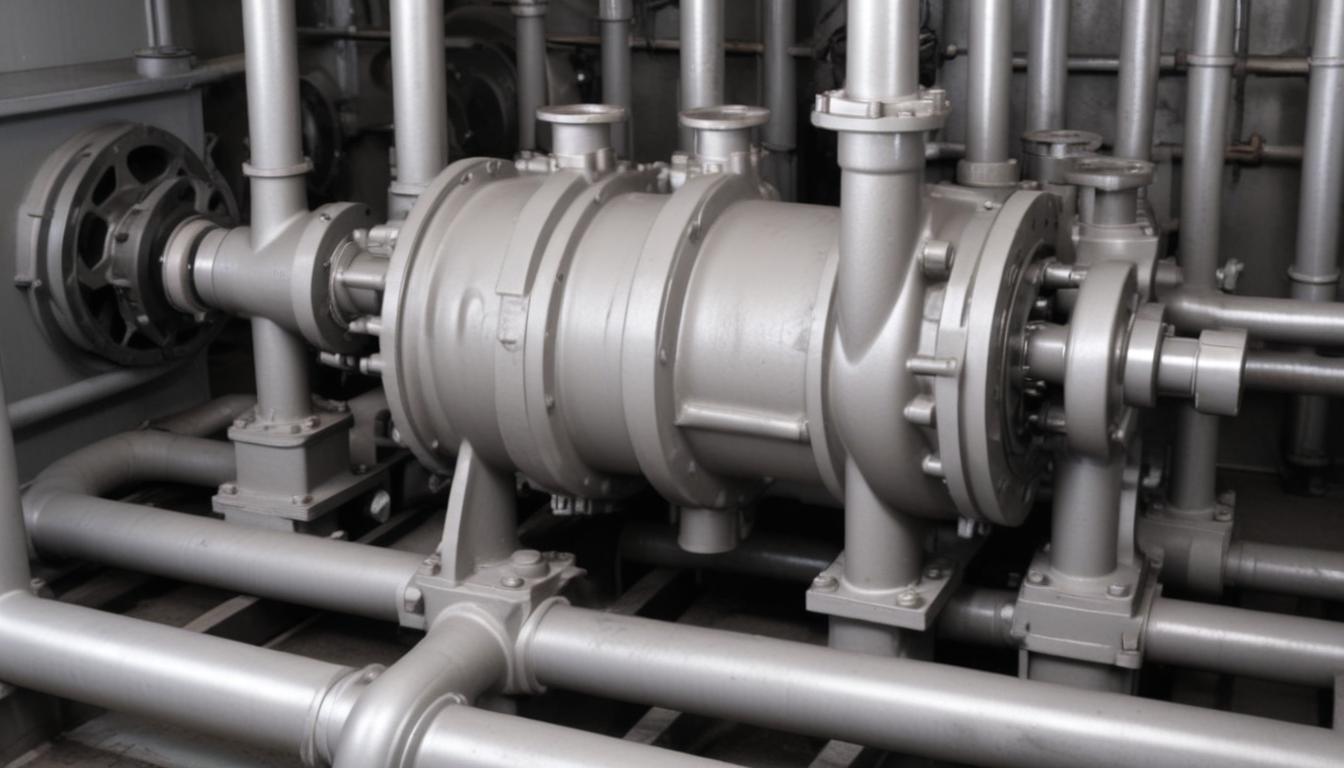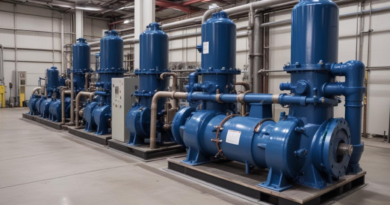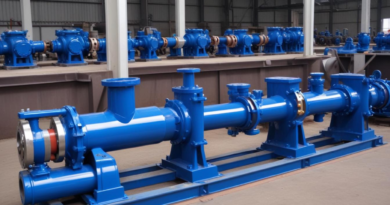how to perform preventive pump maintenance
Pump systems are integral to numerous industrial and commercial applications, serving as the backbone for fluid movement and processing. A comprehensive grasp of their components and operation is essential for effective preventive maintenance.
Key Components of Pump Systems include:
| Component | Function |
|---|---|
| Impeller | Transforms rotational energy into hydraulic energy, facilitating fluid movement. |
| Shaft | Conveys mechanical power from the motor to the impeller. |
| Seals | Prevent fluid leakage along the shaft. |
| Bearings | Support the shaft, reducing friction and ensuring smooth operation. |
| Motor | Provides the necessary power to drive the pump. |
Understanding the types of pumps is also crucial. Common categories include:
- Centrifugal Pumps: Utilize rotational energy to move fluids through centrifugal force.
- Positive Displacement Pumps: Move fluid by trapping a fixed amount and displacing it mechanically.
- Submersible Pumps: Designed to operate underwater, often used in wells and sewage systems.
- Diaphragm Pumps: Use a flexible diaphragm to create a pumping action, ideal for corrosive fluids.
Each pump type has specific applications and maintenance requirements. For instance, centrifugal pumps are favored for their simplicity and efficiency in handling large volumes, whereas positive displacement pumps are preferred for precise flow control.
Operational Principles vary between pump types but generally involve:
- Energy Input: The motor supplies energy to the pump system.
- Fluid Movement: Energy is transferred to the fluid, causing it to move through the system.
- Flow Regulation: Valves and control systems manage the flow rate and pressure.
- Discharge: The fluid is delivered to the designated location or process.
Proper understanding of these principles aids in diagnosing issues and implementing effective maintenance schedules. Regular monitoring of system performance indicators, such as flow rate and pressure, can preemptively identify potential problems, ensuring the longevity and reliability of the pump systems.
Moreover, familiarity with the pump’s installation environment, including factors like temperature, humidity, and exposure to corrosive substances, is vital. These conditions influence the selection of materials and protective measures necessary to maintain optimal pump performance.
By mastering the fundamentals of pump systems, technicians and engineers can better execute preventive maintenance strategies, minimizing downtime and extending the operational lifespan of the equipment.
inspection and cleaning procedures
Regular inspection and thorough cleaning are critical components of an effective preventive maintenance program for pumps. These procedures ensure that pump systems operate efficiently, reduce the likelihood of unexpected failures, and extend the overall lifespan of the equipment.
Inspection Procedures should be systematically conducted to identify potential issues before they escalate. Key inspection tasks include:
- Visual Inspection: Examine the pump and surrounding areas for signs of leaks, corrosion, or physical damage.
- Vibration Analysis: Monitor vibration levels to detect imbalances or misalignments in the pump components.
- Noise Assessment: Listen for unusual sounds such as grinding or rattling, which may indicate mechanical problems.
- Alignment Checks: Ensure that the pump and motor shafts are properly aligned to prevent undue stress on bearings and seals.
- Seal Integrity: Inspect seals for wear and tear to prevent fluid leakage and maintain system pressure.
- Electrical Components: Verify the condition of electrical connections and controls to ensure reliable operation.
A comprehensive inspection checklist can streamline the process and ensure that no critical aspects are overlooked. Below is an example of such a checklist:
| Inspection Item | Description | Frequency |
|---|---|---|
| Leak Detection | Check all joints and connections for signs of fluid escape. | Weekly |
| Vibration Levels | Use vibration meters to assess the balance and alignment of the pump. | Monthly |
| Noise Levels | Listen for abnormal noises during operation. | Monthly |
| Seal Condition | Inspect seals for integrity and replace if necessary. | Quarterly |
| Electrical Connections | Ensure all electrical connections are secure and free from corrosion. | Quarterly |
Cleaning Procedures should be performed meticulously to remove contaminants that can impair pump performance. Regular cleaning helps maintain optimal flow rates and prevents buildup that could lead to blockages or inefficiencies. Key steps in the cleaning process include:
- Shutdown and Safety: Ensure the pump is turned off and properly isolated from the power source to maintain a safe working environment.
- Disassembly: Carefully disassemble the pump components, including the impeller, casing, and seals, following manufacturer guidelines.
- Debris Removal: Use appropriate tools to remove any debris, scale, or sediment from the internal parts.
- Component Cleaning: Clean each part using manufacturer-recommended cleaning agents to prevent damage. Ultrasonic cleaners may be employed for thorough cleansing.
- Inspection During Cleaning: While cleaning, inspect each component for signs of wear or damage and replace parts as necessary.
- Reassembly: Reassemble the pump carefully, ensuring all components are correctly fitted and secured.
- Testing: After reassembly, perform a test run to verify that the pump operates correctly and that all cleaning procedures were successful.
Utilizing the appropriate cleaning tools and materials is essential for effective maintenance. Common tools and materials include:
- Cleaning Agents: Select agents that are compatible with the pump materials to avoid corrosion or degradation.
- Brushes and Scrapers: For removing stubborn deposits and buildup from pump surfaces.
- Vacuum Equipment: To eliminate loose debris and contaminants from the pump casing.
- Protective Gear: Ensure that maintenance personnel are equipped with necessary safety equipment such as gloves and eye protection.
Implementing a structured approach to inspection and cleaning not only enhances the reliability of pump systems but also integrates seamlessly into broader maintenance schedules. By adhering to these procedures, organizations can achieve sustained pump performance and minimize operational disruptions.
lubrication techniques
Proper lubrication is a cornerstone of effective preventive maintenance for pumps, ensuring smooth operation and prolonging the lifespan of critical components. Selecting the right lubricant and applying it correctly can significantly reduce friction, wear, and the risk of mechanical failures.
Types of Lubricants used in pump maintenance vary based on the pump type and operating conditions. Common lubricant categories include:
| Lubricant Type | Applications | Properties |
|---|---|---|
| Mineral Oils | General-purpose lubrication for standard pumps. | Cost-effective, good viscosity, suitable for a wide temperature range. |
| Synthetic Oils | High-performance pumps operating under extreme conditions. | Enhanced thermal stability, superior oxidation resistance, longer service life. |
| Greases | Pumps with slow-moving parts or those requiring longer lubrication intervals. | Thicker consistency, excellent adhesion, reduced frequency of application. |
| Water-Grease Lubricants | Pumps exposed to water or high moisture environments. | Water-resistant, prevents corrosion, maintains lubrication integrity. |
| Dry Lubricants | Applications where contamination from liquid lubricants must be minimized. | No liquid residue, reduces risk of contamination, suitable for clean environments. |
Lubrication Points Identification is essential for targeted maintenance. Critical areas typically include:
- Bearings: Primary points requiring regular lubrication to minimize friction and wear.
- Shaft Seals: Lubrication ensures smooth rotation and prevents seal damage.
- Gearboxes: If present, require appropriate lubrication to maintain gear integrity.
- Couplings: Lubricate to prevent wear from misalignment and rotational movement.
Implementing an effective lubrication schedule involves determining the appropriate intervals and quantities for each lubrication point. Factors influencing the schedule include pump usage, operating environment, and manufacturer recommendations. A typical lubrication schedule may include:
- Daily Checks: Inspect lubrication levels and top up if necessary, especially for pumps in continuous operation.
- Weekly Maintenance: Assess the condition of lubricants and replace if contamination is detected.
- Monthly Tasks: Conduct thorough lubrication of all identified points, ensuring even distribution and adequate coverage.
- Quarterly Reviews: Evaluate the overall lubrication strategy, adjusting the schedule based on wear patterns and operational changes.
Lubrication Methods can be categorized into manual and automated systems:
- Manual Lubrication: Involves physically applying lubricant using brushes, applicators, or oil cans. Suitable for pumps with infrequent lubrication needs or in environments where automated systems are impractical.
- Automatic Lubrication: Utilizes centralized lubrication systems, such as grease dispensers or oil pumps, to provide consistent and timely lubrication. Ideal for large-scale operations with multiple lubrication points and high maintenance demands.
Tools and Materials required for effective lubrication include:
- Lubrication Equipment: Oil cans, grease guns, applicator brushes, and centralized lubrication systems.
- Protective Gear: Gloves and eye protection to ensure safety during the lubrication process.
- Cleaning Supplies: Wipes or rags to remove excess lubricant and prevent contamination.
- Lubricant Containers: Proper storage containers to maintain lubricant quality and prevent degradation.
Best Practices for lubrication in pump maintenance include:
- Follow Manufacturer Guidelines: Adhere to the specific lubrication recommendations provided by the pump manufacturer to ensure compatibility and effectiveness.
- Monitor Lubricant Condition: Regularly check for signs of contamination, such as water ingress or particulate matter, and replace lubricants as needed.
- Avoid Over-Lubrication: Excessive lubricant can attract contaminants and cause operational issues. Apply lubricant in the recommended quantities.
- Maintain Cleanliness: Ensure that lubrication areas are clean to prevent the introduction of debris and contaminants into the pump system.
By meticulously executing lubrication techniques as part of a structured preventive maintenance program, organizations can enhance pump reliability, reduce downtime, and extend the operational lifespan of their equipment.
identifying and addressing wear issues
 Wear is an inevitable aspect of pump operation, arising from the continuous interaction of moving components under various operational stresses. Properly identifying and addressing these wear issues is crucial to maintaining pump efficiency, preventing unexpected downtime, and extending the overall lifespan of the equipment.
Wear is an inevitable aspect of pump operation, arising from the continuous interaction of moving components under various operational stresses. Properly identifying and addressing these wear issues is crucial to maintaining pump efficiency, preventing unexpected downtime, and extending the overall lifespan of the equipment.
Common Wear Issues in Pumps include:
- Bearings Wear: Bearings support the pump shaft and facilitate smooth rotation. Over time, they can suffer from friction-induced wear, leading to increased vibration and noise.
- Seal Degradation: Seals prevent fluid leakage along the pump shaft. Wear and tear can cause leaks, compromising system pressure and leading to contamination.
- Impeller Damage: The impeller is essential for fluid movement. Erosion, corrosion, or physical damage can reduce pump efficiency and cause imbalances.
- Shaft Misalignment: Misaligned shafts can cause uneven wear on bearings and seals, increasing the risk of mechanical failure.
- Casing Corrosion: Exposure to corrosive fluids or environments can degrade the pump casing, leading to structural weaknesses and leaks.
Identification of Wear Issues involves regular monitoring and diagnostic techniques to detect early signs of deterioration. Effective identification methods include:
- Vibration Analysis: Elevated vibration levels can indicate bearing wear, shaft misalignment, or impeller imbalance. Utilizing vibration meters helps in early detection.
- Thermography: Infrared imaging can identify overheating components, suggesting excessive friction or inadequate lubrication.
- Visual Inspections: Regular visual checks can reveal visible signs of wear such as corrosion, leaks, or physical damage to pump components.
- Performance Monitoring: Tracking parameters like flow rate, pressure, and energy consumption can highlight deviations indicative of wear-related issues.
- Acoustic Analysis: Unusual noises such as grinding or rattling can signal internal wear or mechanical faults.
Integrating these identification methods into a structured preventive maintenance schedule ensures timely detection and intervention. Below is a table outlining common wear issues, their symptoms, and recommended corrective actions:
| Wear Issue | Symptoms | Corrective Actions |
|---|---|---|
| Bearings Wear | Increased vibration, unusual noises, elevated operating temperatures. | Replace worn bearings, ensure proper lubrication, realign shafts. |
| Seal Degradation | Fluid leaks, reduced system pressure, contamination. | Inspect and replace damaged seals, verify proper alignment, maintain clean operating conditions. |
| Impeller Damage | Decreased flow rates, imbalanced operation, visible erosion or corrosion. | Repair or replace damaged impellers, adjust operating parameters to minimize erosion, use corrosion-resistant materials. |
| Shaft Misalignment | Uneven wear on bearings and seals, increased mechanical stress, vibration issues. | Realign pump and motor shafts, secure mounting fixtures, regularly check alignment during maintenance. |
| Casing Corrosion | Visible rust or pitting, fluid discoloration, structural weakening. | Apply corrosion-resistant coatings, use appropriate materials for pump casing, implement protective measures in corrosive environments. |
Addressing Wear Issues requires a systematic approach to ensure that corrective measures are both effective and sustainable. Key strategies include:
- Timely Replacement of Worn Components: Proactively replacing parts before they fail prevents larger system disruptions and potential damage to other components.
- Enhanced Lubrication Practices: Ensuring adequate and appropriate lubrication reduces friction and wear, particularly for bearings and seals.
- Material Upgrades: Utilizing more durable or corrosion-resistant materials can mitigate wear in harsh operating conditions.
- Operational Adjustments: Modifying pump operating parameters, such as flow rates and pressures, can decrease stress on components and reduce wear rates.
- Training and Awareness: Educating maintenance personnel on the signs of wear and proper maintenance techniques ensures consistent and effective issue resolution.
Implementing these strategies within a well-defined maintenance schedule enhances the ability to manage wear proactively. Regularly updating maintenance schedules based on wear patterns and operational data ensures that preventive measures evolve with the system’s needs.
By diligently identifying and addressing wear issues, organizations can maintain optimal pump performance, minimize the risk of unexpected failures, and achieve a higher return on investment through extended equipment longevity.
scheduling regular maintenance
Establishing a well-structured maintenance schedule is pivotal for ensuring the longevity and optimal performance of pump systems. A meticulously planned schedule not only facilitates timely preventive actions but also minimizes the risk of unexpected downtimes and costly repairs.
Key Components of an Effective Maintenance Schedule include:
- Frequency of Maintenance Tasks: Determining how often each maintenance activity should be performed based on manufacturer recommendations, operational demands, and historical performance data.
- Task Prioritization: Identifying critical tasks that have a significant impact on pump reliability and safety, ensuring they are addressed promptly.
- Resource Allocation: Assigning necessary resources, including personnel, tools, and materials, to execute maintenance tasks efficiently.
- Documentation and Tracking: Keeping detailed records of all maintenance activities to monitor progress, identify trends, and facilitate continuous improvement.
- Flexibility and Adaptability: Allowing for adjustments in the schedule to accommodate unforeseen issues or changes in operational requirements.
Steps to Develop a Maintenance Schedule involve a systematic approach to ensure comprehensiveness and effectiveness:
- Assess Pump System Requirements: Analyze the specific needs of each pump, including operating conditions, usage patterns, and environmental factors.
- Identify Maintenance Tasks: List all necessary maintenance activities, such as inspections, cleaning, lubrication, and component replacements.
- Determine Task Frequency: Assign appropriate intervals for each task based on criticality and usage, such as daily, weekly, monthly, or annually.
- Allocate Resources: Ensure that the required tools, parts, and trained personnel are available to perform the maintenance tasks as scheduled.
- Implement the Schedule: Deploy the maintenance plan, communicating it clearly to all relevant stakeholders and integrating it into daily operations.
- Monitor and Adjust: Regularly review the schedule’s effectiveness, making adjustments based on feedback, performance data, and changing conditions.
Sample Maintenance Schedule for Pump Systems:
| Maintenance Task | Description | Frequency |
|---|---|---|
| Daily Inspection | Check for visible leaks, unusual noises, and ensure proper alignment. | Daily |
| Lubrication | Apply lubricant to bearings and moving parts to reduce friction. | Weekly |
| Vibration Analysis | Monitor vibration levels to detect imbalances or component wear. | Monthly |
| Seal Inspection | Examine seals for signs of wear or leakage and replace if necessary. | Quarterly |
| Performance Testing | Assess pump performance metrics such as flow rate and pressure. | Semi-Annually |
| Comprehensive Overhaul | Thoroughly disassemble, clean, and inspect all pump components for wear. | Annually |
Factors to Consider When Scheduling Maintenance ensure that the maintenance plan is realistic and effective:
- Operational Demands: High-usage pumps may require more frequent maintenance compared to those with lower operational demands.
- Environmental Conditions: Pumps operating in harsh environments, such as those exposed to corrosive substances or extreme temperatures, may necessitate specialized maintenance schedules.
- Manufacturer Recommendations: Adhering to the pump manufacturer’s maintenance guidelines ensures compliance with warranty conditions and optimal performance.
- Historical Data: Analyzing past maintenance records and failure incidents can help in predicting future maintenance needs and adjusting schedules accordingly.
- Resource Availability: Ensure that the necessary tools, parts, and skilled personnel are available to perform maintenance tasks without causing operational delays.
Utilizing Maintenance Management Software can greatly enhance the efficiency and effectiveness of maintenance schedules. These tools offer features such as:
- Automated Scheduling: Generate maintenance schedules based on predefined criteria and adjust them dynamically as needed.
- Task Tracking: Monitor the progress of maintenance tasks, ensuring timely completion and accountability.
- Inventory Management: Keep track of necessary parts and materials, preventing shortages that could delay maintenance activities.
- Reporting and Analytics: Analyze maintenance data to identify trends, measure performance, and make informed decisions for continuous improvement.
Implementing a robust maintenance schedule as part of a preventive maintenance program not only enhances the reliability and efficiency of pump systems but also contributes to cost savings by reducing unplanned downtime and extending the lifecycle of the equipment. Regularly reviewing and refining the maintenance schedules based on operational feedback and performance metrics ensures that the maintenance strategy remains aligned with the evolving needs of the pump systems.




